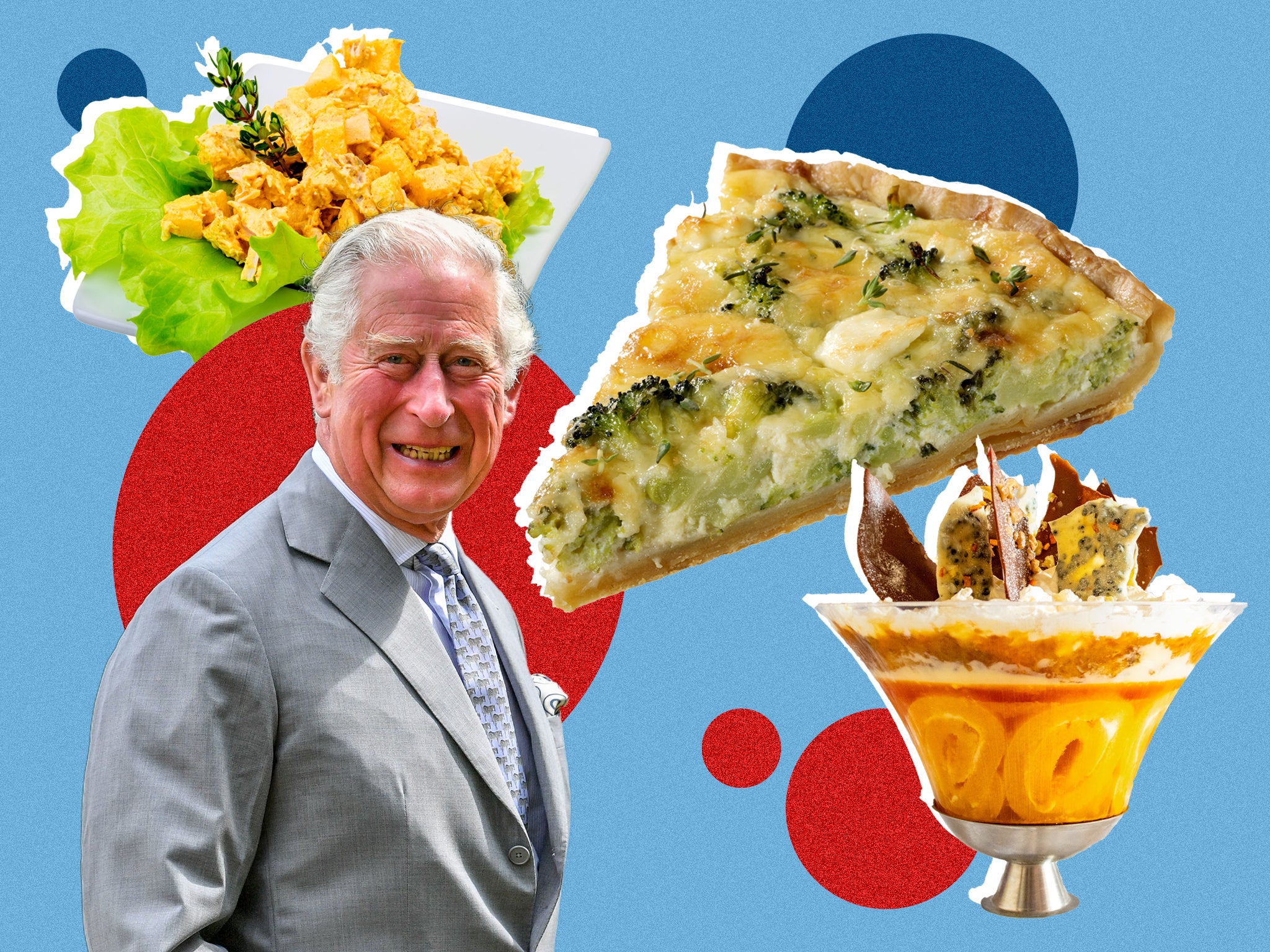Signal as much as IndyEat’s free e-newsletter for weekly recipes, foodie options and cookbook releases Get our Now Hear This electronic mail without cost Please enter a legitimate electronic mail deal with Please enter a legitimate electronic mail deal with SIGN UP I wish to be emailed about presents, occasions and updates from The Impartial. Learn our privateness discover Thanks for signing as much as the
IndyEats electronic mail {{ #verifyErrors }} {{ message }} {{ /verifyErrors }} {{ ^verifyErrors }} One thing went incorrect. Please attempt once more later {{ /verifyErrors }}
Tucking into coronation hen? That’s all a bit 1953. With the crowning of King Charles III only a week away, the dish du jour we’ll be tucking into is the not too long ago revealed “coronation quiche”.
The recipe – which options spinach, broad beans and tarragon – was personally chosen by the monarch and his spouse, the Queen Consort, as a solution to mark the event. Count on to see it on tables throughout the nation through the “Massive Lunch” road celebration celebrations, going down all through coronation weekend.
That it’s vegetarian feels apt, provided that the King has admitted to consuming a plant-based food regimen on sure days of the week, as does the usage of components which are in season proper now, serving to preserve these meals miles down for the famously eco-conscious royal.
Leaving apart the quiche’s apparent “Frenchness” (sure, there have been cream and egg pastry dishes in Italy and England way back to the thirteenth and 14th centuries, however a quiche is a French dish, I’ll hear no extra), the announcement – which garnered a blended response – was a completely fashionable step by the royal household.
Though coronation hen has lengthy been a preferred fixture on the sandwich filling scene, the disclosing of an “official” coronation recipe is, in truth, a brand new idea. Seventy years in the past, for the crowning of the late Queen Elizabeth II, there was no effort to deliver royal eating into the house kitchen.
As a part of the coronation luncheon on 2 June 1953, company had been served “Poulet Reine Elizabeth”, a dish credited to Rosemary Hume and Constance Spry from Le Cordon Bleu London, who catered the occasion, with the unique recipe consisting of “younger roasting chickens, water and a bit wine to cowl carrot, a bouquet garni, salt, peppercorns and a cream of curry sauce” and served with salad of rice, inexperienced peas and pimentos, based on the cookery faculty’s web site.
On condition that many of the UK was nonetheless feeling the results of post-war rationing, it was fairly a exceptional checklist of components. It’s mentioned to have been impressed by jubilee hen, a dish of hen wearing mayonnaise and curry powder created for King George V’s silver jubilee in 1935.
However it’s unlikely that anybody anticipated this to be a stand-out dish, one that may go on a journey from royal meal to Seventies banquet favorite, by to in style sandwich filling (Pret’s newest menu options coronation hen between bloomer bread). Meals historian Dr Annie Grey described the origin story as “all a little bit of a moist squib”.
Coronation hen has confirmed a preferred sandwich filling (iStock)
“Coronation hen was one dish amongst many at a non-public banquet in 1953, and wasn’t known as that till a few years after the coronation,” she tells me.
Consequently, the hyperlink between Queen Elizabeth’s coronation and the creation of coronation hen got here as a shock to some on social media when the royal quiche recipe was introduced.
One Twitter person wrote: “Oh my f**king god… coronation hen… proper in entrance of my face for 28 years with out a clue”.
We discover ourselves in uncharted territory with a recipe to mark the coronation – picked by the king and queen themselves, no much less – however one which’s indicative of a Twenty first-century method to a monarchy that positions itself as hotter and extra open in its relationship with the general public.
Based on Professor Rebecca Earle, from the College of Warwick, this can be a real innovation. “Traditionally, members of the general public weren’t urged to rejoice coronations by inventing new dishes, or by recreating the menus of the official banquets. Dwelling cooks hoping to duplicate the côtelettes de bécassines à la Souvaroff served at Edward VII’s 1902 coronation would have confronted a fancy recipe involving fillets of snipe, pâté, brandy and truffles,” she says.
Coronation hen was one dish amongst many at a non-public banquet in 1953, and wasn’t known as that till a few years after the coronation Dr Annie Grey
“The strategy was later described in royal chef Gabriel Tschumi’s cookbook [Royal Chef: Recollections of life in royal households from Queen Victoria to Queen Mary], nevertheless it was unlikely to encourage any however essentially the most intrepid.
“At this time’s efforts to encourage us all to hitch in by baking a coronation quiche replicate the large reputation of cooking as a leisure exercise, in addition to the monarchy’s makes an attempt to repackage themselves for the Twenty first century.”
Through the 70-year hole between coronations within the UK, recipes have been shared solely on restricted events. To mark Queen Elizabeth II’s golden jubilee in 2002 – and nearly a throwback to Poulet Reine Elizabeth – a recipe of baked hen dressed with creme fraiche, mayonnaise, ginger and lime (and served pasta salad) was revealed. For the platinum jubilee final 12 months, the “Platinum Pudding” was created as a part of a nationwide competitors; the winner was lemon Swiss roll and amaretti trifle, triumphing over 5,000 different desserts.
Britain Platinum Pudding (AP)
However it’s the Empire Christmas pudding that’s often thought-about the primary recipe to have a royal connection – it was created by Henri Cedard, who was head chef at Buckingham Palace – and be promoted as a nationwide dish. The dessert dates again to the Nineteen Twenties, with every of the 17 components coming from someplace within the British Empire. It was extremely in style – one thing of a coup for the Empire Advertising and marketing Board.
With King Charles choosing a smaller coronation than his predecessors, and even eschewing the Commonwealth banquet held by his mom, his celebrations can be a far cry from these of King George IV in 1821.
Again then, the brand new monarch – identified for his penchant for wealthy French meals – adopted custom courting again to the twelfth century by internet hosting a grand banquet underneath the vaulted ceilings of Westminster Corridor. It will be so indulgent that it will deliver this custom to an finish after greater than 600 years; there has not been a coronation banquet there since.
(Reuters)
Greater than 1,500 company gathered round nearly 50 tables for the spectacle, was a multi-million-pound affair in at this time’s cash. Based on The Dialog, the primary course consisted of 20 dishes, equivalent to les filets de poulards, sautés aux champignons (hen sautéed with mushrooms), les cotelles d’agneau, panées, grillées, sauce poivrade (breaded, grilled lamb chops in a pepper sauce), and le paté chaud de caille à l’espagnole (a quail pie, served sizzling).
The programs that adopted had been no lighter, with 22 then 31 dishes, together with sole cooked in champagne, turtle soup and a spun sugar vase crammed with meringues.
9 years later, at a time of financial strife, George’s successor, William IV determined towards such extravagance.
A slimmed-down method from the monarchy and a time of economic disaster, you say? Historical past is vulnerable to repeat itself…










